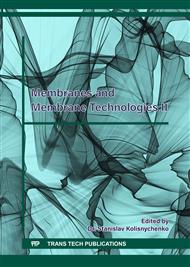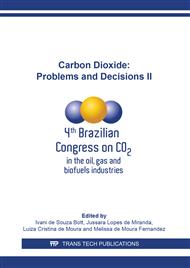[1]
M. Talakesh, M. Sadeghi, M. P. Chenar, A. Khosravi, Gas separation properties of poly(ethyleneglycol)/poly(tetramethylene glycol) based polyurethane membranes. Journal of Membrane Science 415–416 (2012) 469–477.
DOI: 10.1016/j.memsci.2012.05.033
Google Scholar
[2]
A. Isfahani, M. Sadeghi, A. Dehaghani, M. Aravand, Enhancement of the gas separation properties of polyurethane membrane by epoxy nanoparticles. Journal of Industrial and Engineering Chemistry 44 (2016) 67–72.
DOI: 10.1016/j.jiec.2016.08.012
Google Scholar
[3]
M. Sadeghi, A. Shamsabadi, A. Ronasi, A. Isfahanis, M. Dinari, M. Soroush, Engineering the dispersion of nanoparticles in polyurethane membranes to control membrane physical and transport properties. Chemical Engineering Science 192 (2018) 688–698.
DOI: 10.1016/j.ces.2018.08.030
Google Scholar
[4]
M. Sadeghi, M.M. Talakeshi, B. Ghalei, M. Shafiei, Preparation, characterization and gas permeation properties of a polycaprolactone based polyurethane-silica nanocomposite membrane. Journal of Membrane Science, 427 (2013) 21-29.
DOI: 10.1016/j.memsci.2012.07.036
Google Scholar
[5]
M.B. Karami, G. Khanbabaei, G.M.M. Sadeghi, Vegetable oil-based polyurethane membrane for gas separation. Journal of Membrane Science 527 (2017)198-206.
DOI: 10.1016/j.memsci.2016.12.008
Google Scholar
[6]
M. Karimi, G. Khanbabaei, G. Sadeghi, A. Jafari, Effect of nano-silica on gas permeation properties of polyether-based polyurethane membrane in the presence of esterified canola oil diol as a nucleation agent for hard segments. J. Appl. Polym. Sci. 135 (2018) 45979.
DOI: 10.1002/app.45979
Google Scholar
[7]
J. E. VIglio; G. M. Di Giulio; L. C. AND Ferreira. Ambiente & Sociedade. 3 (2017) 21-38.
Google Scholar
[8]
M. Aziz, S. Mousavi, CO2/H2 separation using a highly permeable polyurethane membrane: Molecular dynamics simulation. Journal of Molecular Structure 1100 (2015) 401-414.
DOI: 10.1016/j.molstruc.2015.07.029
Google Scholar
[9]
M. Clemente, R.J. Rocha, K. Iha, Desenvolvimento de tecnologia de pré-polímeros na síntese de poliuretanos empregados em combustíveis sólidos. Química Nova 37 (2014) 982-988.
DOI: 10.1590/s0100-40422013000600009
Google Scholar
[10]
F.M.B. Coutinho M. Delpech, Degradation profile of films cast from aqueous polyurethane dispersions. Polymer Degradation and Stability 70 (2000) 49-57.
DOI: 10.1016/s0141-3910(00)00087-2
Google Scholar
[11]
Hua Li a, B. D. Freemana, O. M. Ekneir, Gas permeation properties of poly(urethane-urea)s containing different polyethers. Journal of Membrane Science 369 (2011) 49–58.
DOI: 10.1016/j.memsci.2010.11.024
Google Scholar



